 It’s inherently vain to post lesson ideas, particulary those including thoughts on how to teach something in this or that situation. Most everyone reading this blog or receiving the email updates already does many things better than me and even more stuff of which I’ve never even thought. And yet…
It’s inherently vain to post lesson ideas, particulary those including thoughts on how to teach something in this or that situation. Most everyone reading this blog or receiving the email updates already does many things better than me and even more stuff of which I’ve never even thought. And yet…
When I have teachers share their own ‘best ideas’ in workshops, they usually hate the part where they’re sharing, but love the part where other people are demonstrating what they do. Sometimes new teachers just need some ‘seed’ ideas to get going, or to add some variety to their relatively young toolbox. Some of my favorite blog posts in the past six months have been other teachers sharing what they’re doing in class, or their personal pedagogy.
So I’ve been gradually building a Classroom Resources section to Blue Cereal. Parts of it are being used regularly, if Google Analytics has any validity. Others… well, they’re still in progress.
But it’s June. Let’s talk about Skills.
[[{“type”:”media”,”view_mode”:”media_small”,”fid”:”3″,”attributes”:{“alt”:””,”class”:”media-image”,”typeof”:”foaf:Image”}}]]
Actually I just wanted to work in that clip. We’ll talk classroom strategies, but first let’s talk Teaching Philosophy. Why listen to someone tell you WHAT to do or HOW to do it if you don’t share any common ground as to WHY?
 If you’ve been with me in a workshop setting, or know me at all, you know I’m a big fan of trusting teachers to know what’s best for their students in their reality in their subject. We absolutely MUST stretch ourselves as professionals, and push past our so-called ‘comfort zones’, yes. Always. But at the other end of that reasoning is a contrasting but equally important truth – follow your gut. Listen to the experts, trust those you trust, think with your brain, but when it’s time – trust yourself.
If you’ve been with me in a workshop setting, or know me at all, you know I’m a big fan of trusting teachers to know what’s best for their students in their reality in their subject. We absolutely MUST stretch ourselves as professionals, and push past our so-called ‘comfort zones’, yes. Always. But at the other end of that reasoning is a contrasting but equally important truth – follow your gut. Listen to the experts, trust those you trust, think with your brain, but when it’s time – trust yourself.
Kinda touchy-feely, right?
Nothing I model in workshops, write in instructions, or post on this website is intended to be even a little prescriptive. None of it’s static. At best it’s a series of efforts to capture some small part of a mindset, the expressions of which will vary greatly by time, place, grade level, student realities, class expectations, and your personal styles & preferences. The important thing on which to focus is this: everything you’ve done up until now is wrong and backwards and you’re ruining the future.
Just kidding, except for about four of you – and you know who you are. Actually my philosophy is closer to this:
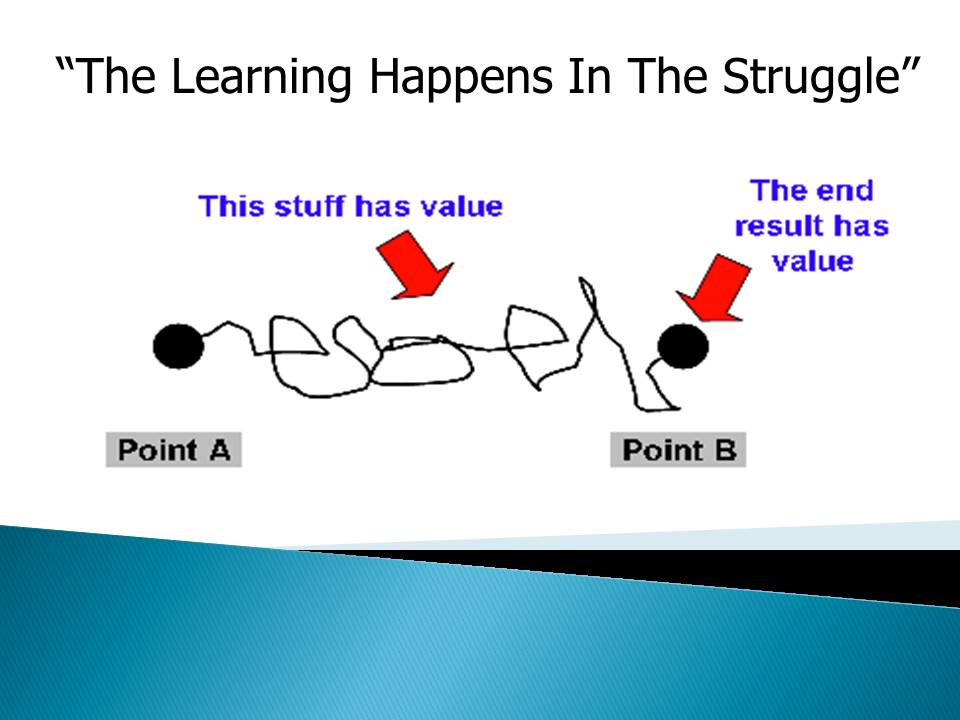
I totally stole this from Ayn Grubb in Tulsa Public, but she never reads my stuff so she’ll never know. Besides, teachers justify pretty much everything in the name of “IT’S FOR THE CHILDREN.”
‘Point A’ is where students are when they come to us – what they know, what they can do, what they think it’s all about, etc. Lest this visual seem overly simplistic, keep in mind that all 168 of your little darlings start at a different ‘Point A’, so already there’s a challenge to this whole ‘teaching’ thing.
‘Point B’ is where you’d ideally like to get them by the time they walk out of your class at the end of the year – what they really need to know, should be able to do, and their mindset about your subject and learning and all that stuff. All of ‘Point B’ is important, even though well-intentioned equally idealistic people are going to suggest in sneaky ways that it’s not. The content matters – our lil’ darlings won’t all just personal-journey-of-discovery it on their own. The skills matter as well, no matter how special and precious and unique and misunderstood Mummy thinks her baby be. (“He’s just not a writer – he’s more of a ramble-incoherently-while-I-swoon style of learner, and I think it’s wrong to try to force them to all be the same!”)
But here’s the thing…
That middle part, what we often refer to euphemistically as ‘the journey’? Yeah, that part matters a whole lotta lot as well, and it’s the part we tend to shortchange.
My best students come to me never having broken an academic sweat in their lives. School has never been difficult for them, and while they are sometimes rather detached from any real value or purpose for any of it, they play the game and their teachers just LOVE them and they all have 104% in every class. The flip side of this is that the first time they’re confused by a concept or struggle with an expectation, they think either I’m unreasonable and/or insane, OR that – oh no, what if – maybe they’re stupid after all!?!
Neither of these is normally the case.
It’s OK that it’s hard. It’s OK that you’re confused. It’s even OK if you fail from time to time – an idea we seem to worship when it’s time to buy motivational posters but loathe when it’s even hinted at in real life.
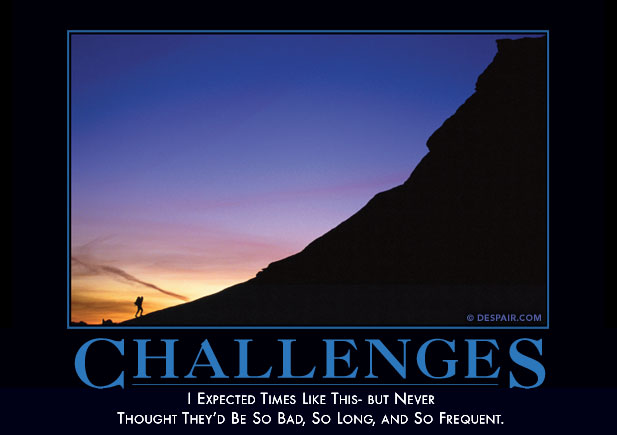
The students I’ve failed most unforgivably aren’t just those who get an ‘F’ in my class but those who pass through without ever being stretched or challenged or forced to outdo themselves a little. This is trendy to say at the moment, but that doesn’t make it less true – struggling and failing and recovering and refiguring and adjusting and attempting and moving forward until you crash and burn again… that’s called ‘learning’.
If they don’t learn to risk, succeed, fail, get confused, frustrated, have epiphanies, rewind, triumph, etc, with ME when it’s relatively SAFE and I love them and desperately WANT THEM TO MAKE IT, one of two things will happen: (1) They’ll learn these lessons in much more painful ways later in high school, college, marriages, careers, parenting, etc., when the stakes are much higher and there’s no tutoring in the library at lunch, or (2) They won’t learn them, and their life will suck.
The learning happens in the struggle. If there’s no struggle, there’s very little real learning. This is a whole prolonged thing we could discuss, but for now I’m just laying it out there as my personal philosophy.
For those of you who are deeply and emotionally invested in the whole ‘grit’ argument, keep in mind that students whose entire worlds are all about chaos and struggle and despair require a slightly different sort of assistance. If the comfortable kids need to be made uncomfortable, it is equally true that sometimes the best thing you can do for a child of dysfunction is provide a little security and predictability in their daily experience. And maybe some protein.
I realize that was a painful amount of hope and inspiration for some of you, but that’s what you get with me – pandas and rainbows. I believe that children are the future. Teach them well and let them – well, you get the idea.
[[{“type”:”media”,”view_mode”:”media_small”,”fid”:”146″,”attributes”:{“alt”:””,”class”:”media-image”,”typeof”:”foaf:Image”}}]]

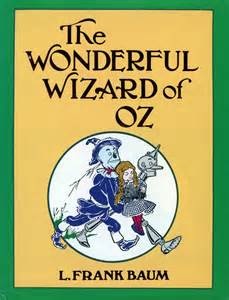 In 1900, L. Frank Baum published The Wonderful Wizard of Oz, a children’s book he wasn’t convinced would do particularly well – not compared to his fabulous Mother Goose and Father Goose collections a few years prior. Turns out it was a hit, and spawned multiple stage versions – usually musicals – and thirteen written sequels by Baum.
In 1900, L. Frank Baum published The Wonderful Wizard of Oz, a children’s book he wasn’t convinced would do particularly well – not compared to his fabulous Mother Goose and Father Goose collections a few years prior. Turns out it was a hit, and spawned multiple stage versions – usually musicals – and thirteen written sequels by Baum. 
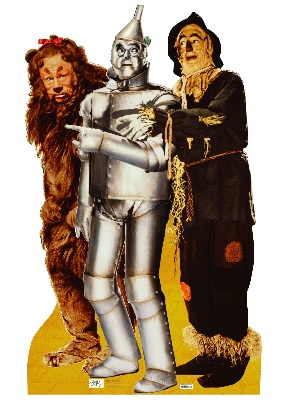 The Tin Man = Northeastern Factory Workers. Having slaved away under dehumanizing conditions for so long, they’d essentially lost their souls – their hearts – the parts which make us most human. Upton Sinclair would capture this less festively a few years later in The Jungle, a book he intended to be about the factory-driven destruction of the human spirit and instead ended up being about how gross sausage is. Meat-packing was reformed; factory labor continued to kill the human spirit for another few generations.
The Tin Man = Northeastern Factory Workers. Having slaved away under dehumanizing conditions for so long, they’d essentially lost their souls – their hearts – the parts which make us most human. Upton Sinclair would capture this less festively a few years later in The Jungle, a book he intended to be about the factory-driven destruction of the human spirit and instead ended up being about how gross sausage is. Meat-packing was reformed; factory labor continued to kill the human spirit for another few generations. 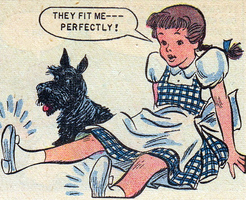 The Yellow Brick Road = The Gold Standard. It’s an almost sacred path to the Emerald City, but one fraught with inconsistency and danger. There are pitfalls and surprises, and even substantial gaps prohibiting all but the most creative travelers for going forward. But, when you add…
The Yellow Brick Road = The Gold Standard. It’s an almost sacred path to the Emerald City, but one fraught with inconsistency and danger. There are pitfalls and surprises, and even substantial gaps prohibiting all but the most creative travelers for going forward. But, when you add…
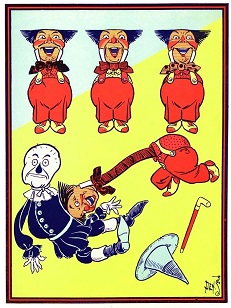 On the other hand, there are plenty of events which even the most creative mind can’t reasonably tie to history or populism. The Quadlings who lack arms but fire their heads at you on long necks are a fascinating obstacle, and the fragile ‘china people’ are far more poignant once you drop the weak ‘unreconstructed South’ connection. And how many varieties of ‘the little people’ (or field mice or Winkies or…) can one book have before it no longer makes sense to label them all with the same Jacksonian value?
On the other hand, there are plenty of events which even the most creative mind can’t reasonably tie to history or populism. The Quadlings who lack arms but fire their heads at you on long necks are a fascinating obstacle, and the fragile ‘china people’ are far more poignant once you drop the weak ‘unreconstructed South’ connection. And how many varieties of ‘the little people’ (or field mice or Winkies or…) can one book have before it no longer makes sense to label them all with the same Jacksonian value?